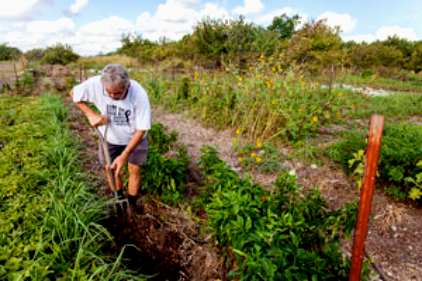
bringing nature, nurseries and gardeners together August 29, 2019
|
|
Nursery notes: Barton Springs Nursery sales: King's mantle clock bush, purple hyacinth bean, skeleton leaf golden-eye all $4.99. Giant blue mistflower 40% off. Open on Monday. ❦
The Natural Gardener sales: all plants 25% off through September 2. 20% off hand weeders, raised bed bags, weed barriers and mulch. Free class on Saturday, 10 a.m. 'The Succulent World of Plants,' with Heather Kendall. On Sunday at 10 a.m. 'Organic Gardening 101.' (Open on Monday) ❦
Wimberley Gardens sales: all trees at 25% off; all mulch 3/$10, and all 4” perennials $1.00 each. ❦
_________________________________________________
Re-potting an orchid: gardeners are often given orchids as gifts - and it can be a challenge to keep these fussy plants alive and well. Writer Kristina Hacker guides us though 'the harrowing task' of transferring your orchid to a new home without killing it. Gardenista ❦
_________________________________________________
Central Texas Gardener: On tour, a visit to Community First! Village where formerly homeless residents are grow-ing new lives through gardens. Jeff Pavlat shows how to make succulent potting mix and how to fertilize and water our plants. Sat. 4 p.m. Sun. 9 a.m. KLRU ❦

The Art of Trench Composting
by Tim Miller As we struggle through the Hades-hot summer of 2019, it seems that this should be a time for us all to modify and tweak our gardening techniques to meet this challenge. One method I have found that works very effectively on my farm is called trench composting. It has a fairly simple set-up, takes most of the work out of composting, and could help to create bountiful crops in all of the organic vegetable patches in Travis and Hays counties. The only tool that you need is a shovel. The hardest part is the digging of the trench, which can range from 3 feet to 6 inches deep. The depth which you dig will depend on the depth of your soil, and your physical energy. (It's probably best to work on this project in the cooler months.) Dig down what you can remove with ease. Then soak the trench and come back two days later and proceed to remove the soil to the depth that you want. The trench only needs to be one shovel blade wide for community garden sites. After digging and throwing the soil onto the adjacent bed you can now start filling in your trench with whatever material you have available. Putting corn and okra stalks on the bottom, then a foot layer of grass clippings will ensure the stalks of heating up. Additional materials could be leaves, hay, woodchips and other garden debris. Fill the trench up to the top of the bed before you start digging your bed. If you start digging the bed before the trench is filled the sides will collapse. After filling it in, treat the trench as a pathway to walk on, and in 6 months the materials will have decomposed. All it takes then is a simple shoveling of the compost onto the planting bed, then filling in the trench before incorporating the compost into your bed. This method is a time-saver if used correctly. Even with a cold front passing by, you can loosen up the trench with a tiller or digging fork, then cover your whole garden with row cover and you’ll save your crops from freezing. The heat will permeate up from the trench but will be trapped by the row cover. ________________________________________________ The Benefits of Trench Composting 1 Time saved because you will not have to turn material. 2. With the addition of organic material directly into the ground the root systems of squashes, tomatoes, basil and okra will alter their growth towards and under the trench. 3. Rain and watering your trench will leach out nutrients for the established plants. 4. You will not get muddy feet when walking on the trench pathway that was filled with leaves. 5. Heat generated from decomposition will warm your garden during cold periods. 6. This is a method for stockpiling lots of leaves. 7. For community gardeners who leave their garden, the next gardener will have a supply of compost on hand. 8. Trenches are not unsightly like most compost bins and materials are needed to build it other than a shovel. 9. Weeds will not grow in the trenches. 10. Compost is right next to the garden bed. No more hauling compost around in wheelbarrows. ________________________________________________ Tim Miller has been running the certified organic Millberg Farm in Kyle since 1989. |
 It's About Thyme Legacy Publications.
Contact newsletter editor Darrel Mayers with any ideas for articles or interesting links at internationalrain@yahoo.com (hitting 'reply' to this email won't work) |
|
|